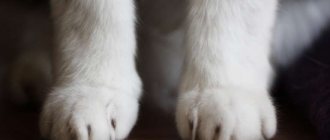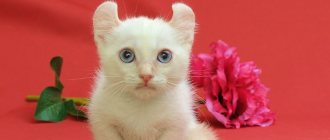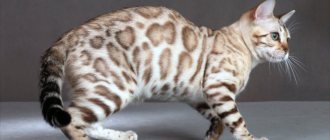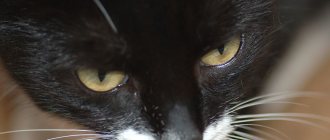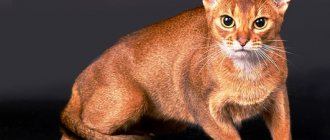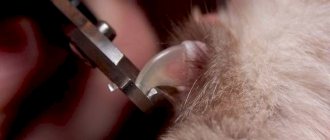Scientific classification
- Kingdom: Animalia (animals)
- Phylum: Chordata
- Class: Mammalia (mammals)
- Order: Carnivora (predatory)
- Family: Felidae (felines)
- Genus: Puma (cougars)
- Species: Puma yagouaroundi (jaguarundi)
Another scientific name for the genus "Herpailurus" comes from the Latin word "herpa" ("strange") and the Greek word "ilurus" ("cat"). The specific name "yagouaroundi" comes from the word "yagua", which refers to all carnivorous animals, and the ending "rundi", probably derived from the word "hung'i", meaning "brownish". “Strange brown cat” perfectly describes the jaguarundi.
To get or not to get a kitten?
Many people want to have an attractive and unusual animal at home. But before you buy a kitten, you need to understand the following:
- - exotics are expensive, the price of a kitten reaches 20-25 thousand dollars, this is the most expensive cat in the world;
- — the veterinarian may refuse to examine and treat the predator;
- — the instinct of a predator, even one raised at home, can present unpleasant surprises;
- - the desire for loneliness and love for large territories can create problems for the animal and its owner.
IMPORTANT! Whether or not to get an exotic kitten should be decided not based on fashion, but by listening to the voice of reason and weighing your options.
Varieties
Scientists identify eight subspecies of jaguarundi:
- Puma yagouaroundi ameghini – Argentine province of San Luis;
- Puma yagouaroundi cacomitli - Mexican state of Tamaulipas and southern Texas;
- Puma yagouaroundi eyra - mainly Paraguay, certain areas of Brazil and Argentina;
- Puma yagouaroundi fossata – Mexican state of Yucatan and Honduras;
- Puma yagouaroundi melantho - Peruvian region of Huanuco and some states of Brazil;
- Puma yagouaroundi panamensis – Panamanian province of Chiriqui;
- Puma yagouaroundi tolteca – Mexican state of Sinaloa and American state of Arizona;
- Puma yagouaroundi yagouaroundi – Amazonian forests and Guyana.
Spread range
Geographical distribution
Photo: Wikipedia
The ancestors of the jaguarundi likely evolved in Eurasia and migrated to the Americas across the Bering Landscape about 16,000 years ago . These wild cats now have a wide geographic distribution, extending from southern Texas to the eastern and western lowlands of Mexico, through the inter-Andean valley of Peru, into southern Brazil and Paraguay, into the provinces of Buenos Aires and Rio Negro in Argentina. There have been several recorded sightings of the jaguarundi in Florida, and a small population here may have resulted from introduction (accidental or deliberate relocation) by humans.
- Biogeographic regions: ocarctic, neotropical
Habitat
These cats inhabit a wide range of open and closed habitats: from wet grasslands, plains near bodies of water, dry bushes and swampy savannas to virgin tropical forests. Access to dense ground cover and dense ground vegetation appears to determine habitat suitability for the jaguarundi. They prefer forest edges and secondary scrub, although this may simply be where they are most often found.
Photo: Happy Hootenanny
These cats are rarely found deep in forests, but often live in open lowlands near shelters. There have been reports of jaguarundis found at altitudes ranging from 2,000 to 3,200 meters above sea level.
- Habitat: temperate, tropical
- Terrestrial Biomes: Savannah, Wet Grassland, Chaparral, Coastal, Rainforest, Shrub
Home range
The personal territories of jaguarundis vary greatly between populations. A radiotelemetry study in Belize showed that the habitats of these cats are enormous . The territories of males and females vary significantly: 88-100 km² for adult males and 13-20 km² for adult females. Male ranges overlap by less than 5%. Both sexes periodically use different areas within their widely dispersed ranges, rather than regularly patrolling the boundaries.
In Brazil, jaguarundis have a very low density of 1-5 cats per 100 km², but in Mexico their population is estimated at 20 cats per 100 km². Increasing numbers of cats in the population result in smaller home ranges and more overlapping territories.
Photo: Miroslav Heran
Population density also depends on habitat. For example, in the Brazilian savannas, home ranges for females and males ranged from 18 to 40.2 km2, whereas in the forest-farmland mosaic they ranged from 1.4 to 34.9 km2. By comparison, a study conducted in the Mexican plains found that males' personal territories were 9.6 km2 and females' territories were 8.9 km2, with significant overlap between the sexes.
Natural enemies of the jaguarundi
Photo: What a jaguarundi looks like
Jaguarundi grows in small sizes, so the cat has plenty of enemies in wild natural conditions.
The predator's ill-wishers include:
- cougars;
- coyotes;
- ocelots;
- other close relatives of pumas.
It is not for nothing that the jaguarundi leads a secretive and inconspicuous life; the cat is very careful and suspicious. She will never be the first to attack a larger enemy, but would rather sit out in dense growth or leave the path on which she senses the presence of a strong enemy. If a fight is inevitable, then the jaguarundi will show all its courage and fearlessness; the battle is usually bloody and, unfortunately, the jaguarundi is often defeated, because the strength of the opponents is not equal. The ability to hunt during the day is very helpful for the jaguarundi, because at this time almost all other predators are sleeping.
Interesting fact: Jaguarundi have always been considered solitary animals, but recent studies have shown that they live in pairs or even small groups in some areas.
People who destroy animals, often invading their farm plots, can also be considered feline enemies. Local farmers simply cannot stand the jaguarundis that raid their fields and farmsteads. Man is displacing the jaguarundi from its habitable places, conducting his tireless economic activity, which also negatively affects the life of the predator, which is forced to look for new areas to live.
Character traits
Appearance
The Jaguarundi is considered a cat with relatively few feline traits . In appearance it resembles a Sumatran cat, but larger and without the dark lines on the cheeks.
Photo: Hedwig Vanhaevre
They differ from other smaller species of neotropical felines by their elongated body, small rounded ears, short thin limbs (relative to the length of the head and body) and uniform (at any age) polymorphic hair. Their head does not have rounded contours, it is slightly flattened and elongated. The eyes are small, close-set, light amber or honey brown in color. The tail is long and fluffy. A jaguarundi cannot completely remove the claws of its hind paws, just like a cheetah.
Coloring
Short and smooth fur of a uniform color throughout the body, sometimes the head, neck and ventral side have a lighter shade. The hair is typically light at the base and tip, giving some animals a gray-haired appearance. It is noteworthy that the jaguarundi is one of the few cat species in which the back of the ears does not have a contrasting color.
Photo: Eze Vivas
The coat can have three colors : blackish, brownish-gray and reddish-brown. Dark or gray fur is usually characteristic of inhabitants of damp, dense forests, while individuals from arid, open habitats have a reddish-brown coat. Black-haired jaguarundis are more associated with tropical forests. However, cats of all colors can be found in all habitats.
The blackish-brown jaguarundi is sometimes mistaken for a tayra. The latter, however, always has a distinct buffy-yellow or orange-yellow patch on the throat.
Previously, the red variety was considered a separate species, but today it is known for certain that cubs with different coat colors can be born in the same litter.
Dimensions
This is a medium sized animal. Of all the small neotropical cats, only ocelots are larger than jaguarundi. The length from the tip of the nose to the tip of the tail ranges from 84 to 137 cm, weight - from 3.5 to 9.1 kg. The tail makes up about two-thirds of the length of the head and body.
- Sexual dimorphism: male is larger
- Body length (without tail): 53-77 cm
- Tail length: 31-60cm
- Shoulder height: 25-35 cm
- Body weight: 3.5-9.1 kg
Notes[ | ]
- Sokolov V. E.
Five-language dictionary of animal names. Mammals. Latin, Russian, English, German, French. / under the general editorship of academician. V. E. Sokolova. - M.: Rus. lang., 1984. - P. 108. - 352 p. — 10,000 copies. - Mel Sunquist, Fiona Sunquist.
Wild Cats of the World. — University of Chicago Press, 2002-08-15. — 463 p. — ISBN 9780226779997. - ↑ 1 2 3 Sunquist, M.;
Sunquist, F. Wild Cats of the World (unspecified). - Chicago: University of Chicago Press, 2002. - pp. 113-119. — ISBN 0-226-77999-8. - Doris H. Wurster-Hill, C. W. Gray.
Giemsa banding patterns in the chromosomes of twelve species of cats (Felidae) (english) // Cytogenetic and Genome Research. - 1973. - T. 12, issue. 6. - pp. 377–397. — ISSN 1424-859X 1424-8581, 1424-859X. - doi:10.1159/000130481. - South Texas Wildlife Management. Endangered Species. (English). Texas Parks & Wildlife. Date accessed: May 16, 2021.
Lifestyle and behavior
This cat is difficult to trap due to its cowardice and secrecy, so little detailed information has been collected about the jaguarundi's temperament. It is known that they are predominantly terrestrial animals , although they can also move through trees with great agility and speed, especially when being pursued. These cats sometimes chase monkeys, jumping from branch to branch, while their long tail helps them balance. Jaguarundi are good jumpers. When catching birds, they can jump up to two meters high. Like the fishing cat, the jaguarundi is an excellent swimmer.
Photo: João Vitor Andriola
Unlike most wild cats, the jaguarundi is active during the day . He hunts mainly in the morning and evening. Activity peaks between 10:30 and 11:30 and 14:00 and 16:00, with very little activity after sunset. This behavior helps minimize competition with the ocelot, which is active at night. At night, jaguarundis rest in the trees.
These cats lead a solitary lifestyle , although they are able to tolerate the presence of other individuals of their species. They travel and collect food in pairs mainly during the breeding season.
Reproduction
In the wild, jaguarundis lead a rather hidden life, so observing them for a long period of time is quite problematic. In this regard, zoologists do not have enough information about all the details of the mating season of wild cats. It is known that the period of puberty occurs late in these animals, when the animal is about 3 years old.
Males, as soon as the mating period begins, come as close as possible to the territory where the females live. At first, the female may respond to the male’s advances quite aggressively, not letting him get close to her. In the process of conceiving new kittens, the male growls loudly, and at the end of the process he sinks his teeth into the female’s withers.
There is no one specific period when jaguarundi mating occurred. The breeding period depends entirely on the climatic conditions in which the animal lives. Individuals inhabiting the tropics can mate in any season of the year. Wild cats living in areas with a temperate and fairly cool climate choose March and September for mating.
In captivity, animals breed twice a year. The duration of pregnancy is about 60-75 days. The number of kittens in one litter is 4. Despite the fact that puberty occurs quite late in cats, the development of kittens occurs rapidly.
When a baby turns 3 months old, his digestive system can already digest food of animal origin. Offspring at this age can gradually begin to hunt, first going out into the open with their mother. As they quickly mature, they begin to hunt game on their own, demonstrating natural hunting skills and instincts.
Find out what other breeds of wild cats exist:
- pampas cat;
- clouded leopard;
- Canadian lynx.
Communication and perception
Jaguarundi have good hearing , the upper limit of audibility is 100 kHz. These animals have a unique characteristic that is very unusual among cats: they use no less than thirteen different sounds to communicate, ranging from purrs to whistles and bird chirps. During reproductive receptivity, the female rolls over onto her back and makes a faint whine.
Jaguarundi is a territorial animal . It marks the boundaries of its home range in several ways: spraying urine, scraping wood and ground with its claws, wiping objects with its head and neck. If personal space is violated, the animal begins to loudly hiss and/or spit.
Photo: Animal Vogue
The tactile channel of perception is involved in communication between kittens, a mother and her offspring, as well as between sexually mature couples. The female screams loudly during mating, and the male gently bites her on the neck.
Eating habits
These carnivores hunt primarily on the ground. Their diet typically consists of small rodents, birds, lizards, amphibians and reptiles, which are also hunted by coyotes, mountain lions, bobcats and foxes. Prey weighing more than 1 kg, such as rabbits, opossums and armadillos, are not unusual for feral cats. Jaguarundis also hunt poultry throughout much of their range. They sometimes feed on chinchillas, iguanas, guinea pigs, bristly rats, monkeys and fish.
Like other felids, the jaguarundi can consume small amounts of arthropod insects and vegetation (leaves and fruits). They were also seen eating a small deer, but this could have been carrion.
Photo: ZooChat
The average weight of vertebrate prey per day is 400 grams. In captivity, the average daily food intake of meat (dead and live chickens) is about 400-450 grams.
Content Features
What should the diet be like?
The fruits of the fig tree are a favorite delicacy after meat.
Since jaguarundis are carnivores, they prefer meat. The animal will not refuse rodents, lizards, and various insects. However, it is important not to forget that the wild cat is almost the only one who prefers plant foods. You will need to include grapes and bananas in your pet's menu. We especially love this representative of the feline figs.
Subtleties of care
The behavior pattern of the owners is directly related to what kind of jaguarundi will grow up: a wild predator or an affectionate pet. It is important to take care of the feeding process. It is recommended to build it as a kind of communication ritual. By starting to raise a wild cat from a young age, you can get an obedient animal who will understand that for good behavior he will receive his favorite treat. As the wild cat grows up, care will become easier. It is imperative to remove the claws of a wild cat, as it can seriously injure members of the household.
Reproduction
Breeding season
The reproductive season lasts throughout the year with peaks in different months, depending on the area. In the northern part of their range, the breeding season is late autumn (November-December). Estrus lasts 3-5 days, during which time females emit a scent that attracts males. The estrous cycle lasts 54 days.
Pregnancy lasts 63-75 days. Females have three pairs of nipples. Litter sizes range from one to four kittens, with the average litter size being 2 pups. Females give birth to about nine kittens over their lifetime. Dens are made in dense thickets, fallen logs, a cave or a hollow tree.
- Mating system: polygamy
- Breeding interval: once or twice a year
- Gestation period: 9-10.5 weeks
Cubs development
Photo: Brněnská Drbna
Newborns are deaf and blind, like all other kittens. They have spots on their bellies that disappear as they grow older. At about 6 weeks of age they begin to eat solid food, but the first attempts are made at about 3 weeks. The offspring leave the den after 28 days. Sexual maturity is reached at approximately 24-36 months. Life expectancy in captivity is up to 10-15 years.
- Range of number of offspring: 1-4 cubs
- Weaning range: 21 to 30 days
- Age of sexual or reproductive maturity: 2 to 3 years
Life in captivity, care
Indian tribes living in Panama tamed jaguarundis and used them as protection against mice and rats. Having become enemies of farmers, the animal again began to live only in natural conditions.
Today, the wild cat is once again becoming a popular exotic pet. Keeping an animal in captivity requires some effort. You shouldn't have it in an apartment. To create a normal living environment, a private house with a large plot of land is suitable, where you can create conditions close to natural. There should be a place where the cat can hide. There must be trees, and at least a small pond, even an artificial one, is desirable.
The diet of a homemade jaguarundi should include raw rabbit, chicken, turkey, and fresh lean fish. The cat will not refuse treats in the form of fruits and berries. It is strictly forbidden to give ready-made, dry or wet food!
A predator remains a predator in captivity. To maintain the hunter's instinct, poultry or a small animal must be released into the jaguarundi's territory. An exciting hunt is guaranteed for your pet! This will have a beneficial effect on the animal’s immunity and will cheer him up.
An adult cat does not need special care. Regular feeding and keeping the habitat clean are mandatory. To raise not a wild animal, but a pet, you need to often communicate with the animal, feed it by hand, and pet it.
But it is better to avoid communicating with children: a jaguarundi can cause injury and frighten a child.
In captivity, a cat lives 15 years.
Save Status
Jaguarundi fur has no commercial value , so the animals are not hunted for their pelts. But these cats are easily tamed and become good pets, so catching jaguarundi kittens is quite a profitable business for poachers. However, their captive breeding still leaves much to be desired.
These animals have the lowest conservation priority and are therefore not listed on the IUCN Red List.
Because little is known about the jaguarundi, its status must be periodically reviewed. There is an urgent need for further research into its demography and habitat to identify threats and their consequences, and to enable adequate conservation measures to be taken. But it is already obvious that the intensive transformation of savannas into industrial agricultural landscapes will negatively affect the jaguarundi population, but it is not yet clear how much.
Although the actual population size is unknown, hunting of jaguarundi is already prohibited in Argentina, Belize, Bolivia, Colombia, Costa Rica, French Guiana, Guatemala, Honduras, Mexico, Panama, Paraguay, Suriname, Uruguay, United States and Venezuela. In Peru, hunting is regulated. But in Brazil, Ecuador, El Salvador, Guyana or Nicaragua, these wild cats are not protected by law.
Price
The price of a Jaguarundi can reach $24,000. This breed is considered one of the most expensive wild felines in the world. In addition, the jaguarundi is very rarely found as a pet. In Latin America and many European countries, it is legally prohibited to sell cats of this breed. Finding ads and buying Jaguarundi is very difficult.
Jaguarundi kittens I. Jaguarundi kittens.
Considering the novelty and high cost of the breed, there are no reviews on our forum or website yet. If you have them, you can add a comment below.



